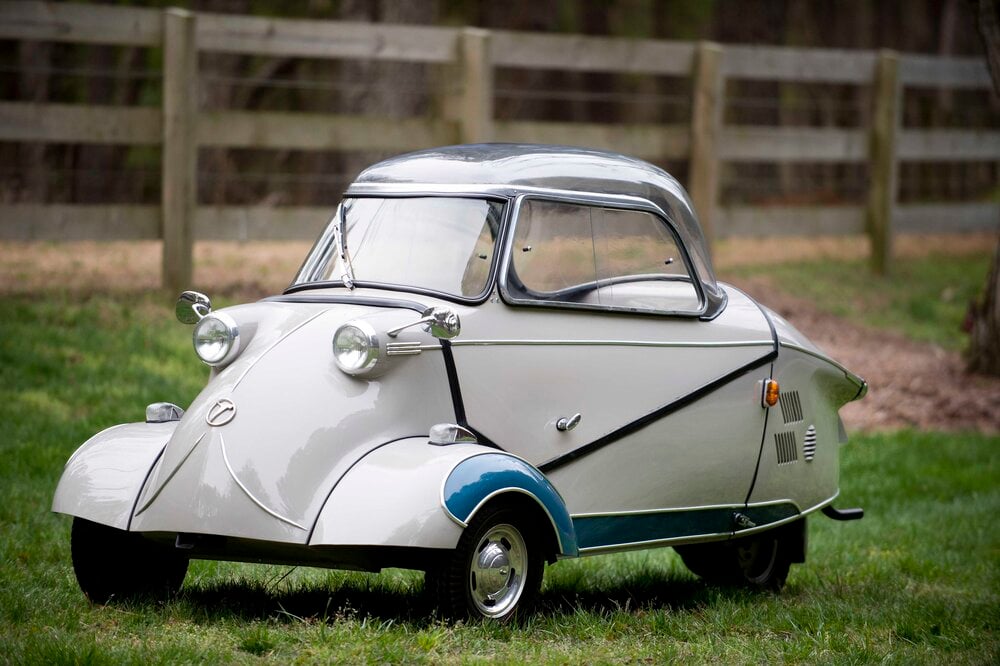Messerschmitt Kabinenroller: A Microcar Revolution
The Messerschmitt Kabinenroller, also known as the KR200, was a microcar born out of post-World War II necessity in Germany. A collaboration between Fritz Fend and Messerschmitt led to the creation of the KR175 in 1953, which was followed by the more successful KR200 in 1956. The Kabinenroller's unique design, heavily influenced by aircraft engineering, featured tandem seating, a bubble canopy, a handlebar for steering, and other aircraft-inspired elements. It was powered by a 191cc Fichtel & Sachs two-stroke single-cylinder engine with a power output of 10 hp and could reach speeds of over 90 km/h. The KR175 and KR200 models were the most well-known, with over 55,000 units produced, and their affordability and fuel efficiency made them a popular choice for personal transportation during the post-war era. Today, Messerschmitt Kabinenrollers are highly sought after by vintage car collectors and enthusiasts.
MICRO CARSMESSERSCHMITT 1950'STWO STROKEGERMANY
11/5/20233 min read


Messerschmitt Kabinenroller: A Microcar Revolution
Introduction
The Messerschmitt Kabinenroller, also known as the KR200, holds a prominent place in automotive history. Born out of post-war necessity and ingenuity, this unique vehicle redefined the boundaries of personal transportation. Crafted and perfected by the combined efforts of German aircraft engineer Fritz Fend and aircraft manufacturer Messerschmitt, the Kabinenroller radiated innovation and hope amidst economic hardship. Often likened to a cockpit on wheels, the Kabinenroller embodied a revolution in microcar design, with its distinctive bubble canopy, tandem seating, and aircraft-inspired elements setting it apart from conventional vehicles of its time.
Historical Context
The birth of the Messerschmitt Kabinenroller can be traced back to the challenging post-World War II circumstances in Germany. In the backdrop of widespread destruction, economic instability, and the impositions of the Treaty of Versailles, Germany was grappling with the urgent need for inexpensive and efficient personal transportation. The affordability and fuel-efficiency of microcars, like the Kabinenroller, made them an attractive solution for the masses, who were working towards rebuilding their lives. The backdrop of Germany's transformation sets the stage for the Kabinenroller's creation, highlighting not only the economic necessity but also the resilience and innovative spirit of post-war Germany.
Origins and Development
The dynamic collaboration between Fritz Fend, an aircraft engineer, and Messerschmitt, an aircraft manufacturer, led to the creation of the iconic Messerschmitt Kabinenroller. In a time when Messerschmitt was temporarily not allowed to manufacture aircraft and had diverted its resources to making other products, Fend seized the opportunity to approach them with the idea of manufacturing small motor vehicles. These were a natural evolution of the 'Fend Flitzer' invalid carriage, which Fend had designed previously. The result was the creation of the first vehicle, the KR175. It bore the Messerschmitt name, emblem and design ethos, but was manufactured and marketed by a newly incorporated company, Regensburger Stahl- und Metallbau GmbH. Addressing early design issues led to the development of its more successful successor, the KR200, in 1956, forever marking Messerschmitt's place in automotive history.
Design and Features
Recognized for its distinctive bubble canopy and unconventional design, the Messerschmitt Kabinenroller intrigued many with its unique aesthetic. Its design, heavily influenced by aircraft engineering, featured tandem seating - a trait where the passenger seat was behind the driver seat, making it a two-seater vehicle. The fusion of motor scooter and cockpit-like design manifested in the handlebar for steering (with twist-grip throttle and clutch lever). The car was replete with a kick starter and even a hand-operated windshield wiper. One thing it initially lacked was a reverse gear. The Kabinenroller's ingenious design made it a unique vehicle - an enticing choice for those seeking affordable yet efficient transportation solutions in the post-war era.
Technical Specifications
Powered by a 191cc Fichtel & Sachs two-stroke single-cylinder engine which could operate in both directions, the KR200 had a power output of 10 hp. Despite its modest power, the KR200's light weight, low aerodynamic drag, and meticulous engineering allowed it to clock speeds in excess of 90 km/h. The vehicle's bodywork was configured in a rear mid-engine, rear-wheel-drive layout paired with a sequential, unsynchronized four-speed transmission that could operate in forward or reverse depending on the engine's rotation. This carefully engineered combination of lightweight, aerodynamic design and efficient power transfer delivered remarkable fuel efficiency, making the Kabinenroller a practical solution for personal transportation.
Variations and Models
The Messerschmitt Kabinenroller, namely the KR175 and the KR200, are the most well-acknowledged models in the production line. From 1953 to 1964, the Kabinenroller's design evolution was substantial, with improvements made on user experience and technical enhancements. For example, the KR200, which replaced the KR175, housed an upgraded engine and introduced a reverse gear, which was a much-missed feature in its predecessor. The excellence of these models is reinstated by their popularity and impact, with over 55,000 units produced, as they became one of the top choices representing affordable and efficient mobility.
Popularity and Impact
The KR Kabinenrollers quickly gained popularity due to their unique design and affordability. The cars could easily navigate the damaged road conditions in post-war Germany, making them a popular choice for personal transportation during that time. Their impact extended beyond Germany and the European continent, becoming a symbol of post-war mobility and ingenuity in many parts of the world. Today, the Messerschmitt Kabinenroller still draws attention. Its innovative design, market impact, and socio-economic significance have transformed the Kabinenroller from a basic necessity to a cherished collectible, signifying its enduring impact.
Collectibility and Restorations
Given their rarity and historical importance, Messerschmitt Kabinenrollers are much sought after by vintage car collectors and enthusiasts. With an estimated 15,000-20,000 units of the KR175 model and an overall production exceeding 55,000 units for all models, their value at auction provides an indication of their collectibility. For example, a fully restored 1954 KR175 model, once part of the renowned Bruce Weiner Microcar Museum, has fetched impressive prices at auction. The ongoing preservation and restoration of these vehicles highlight their enduring charm, making them a significantly collectible part of automotive history.
